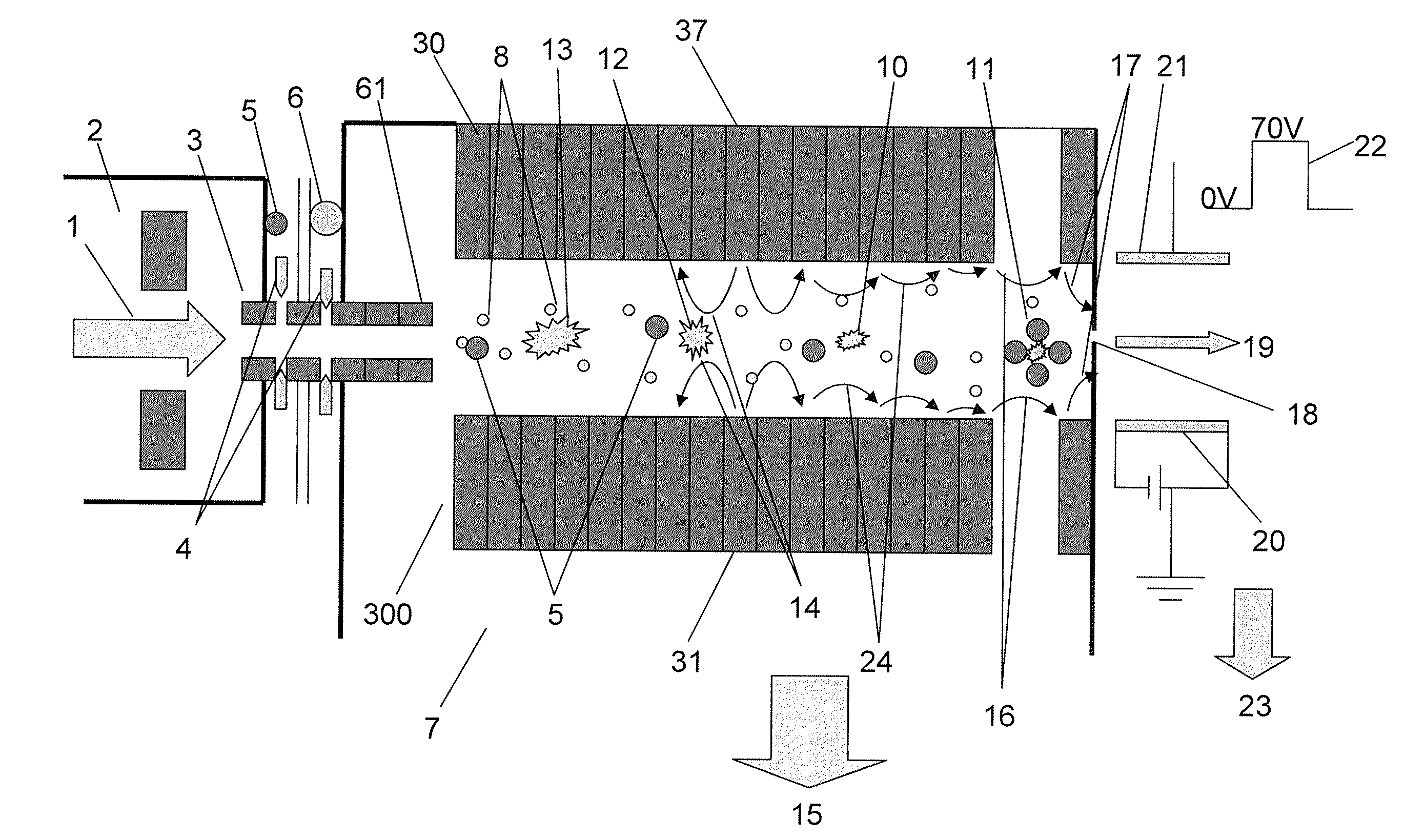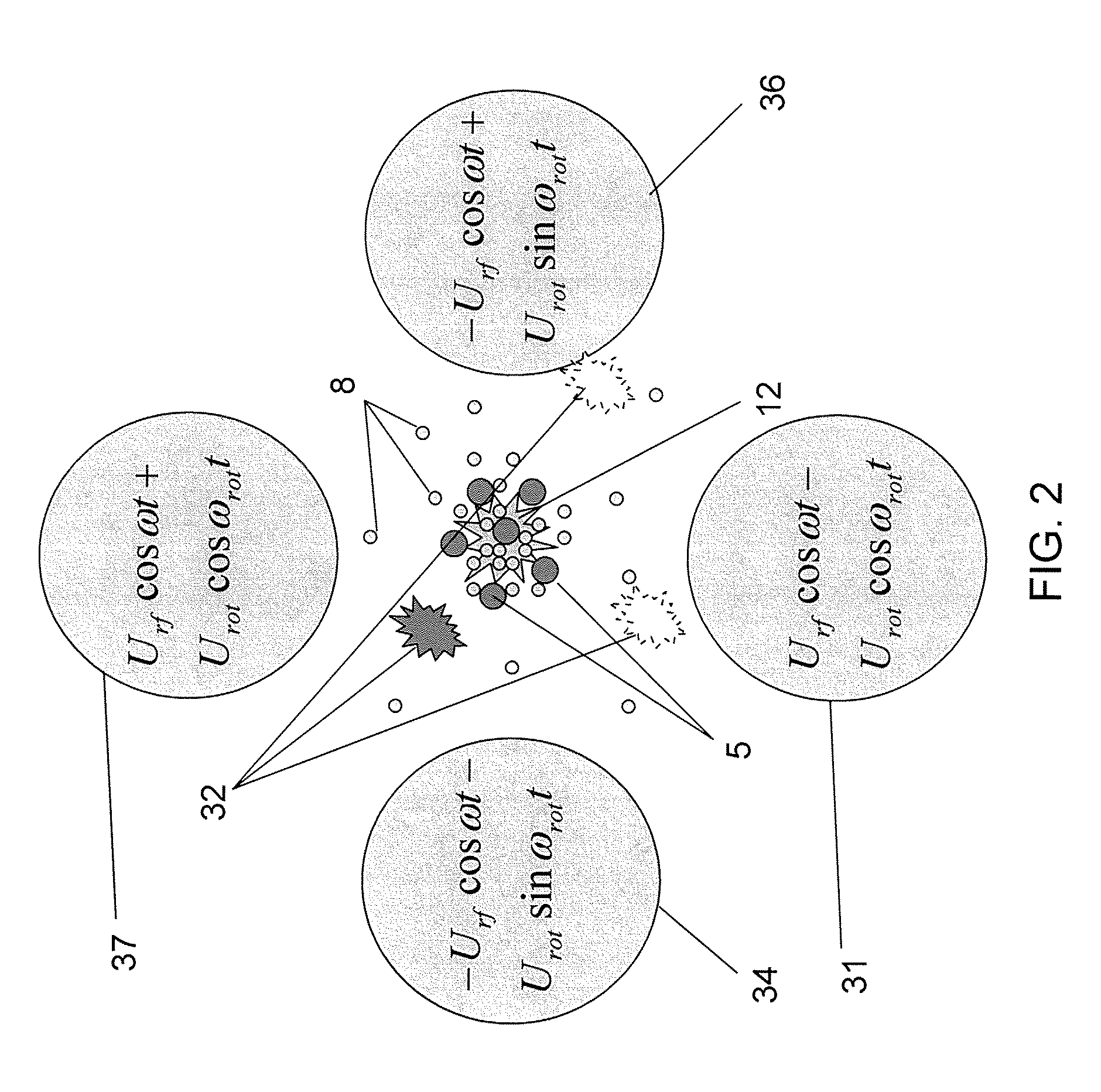The problem is how to efficiently organize ion mobility separation using gas counter-flow.
The main problem then is how to overcome the strong counter-flow and preserve ion
throughput.
Some separation of ions in addition to the usual mobility separation is achieved in this case, however, it is often rather small, because of the
diffusion broadening during the initial ion cloud formation.
Such type of ion accumulation is restricted to collecting relatively small number of ions due to space-charge effects.
It also has some limitation in ion
mass-to-charge (m / z) range because RF-focusing for a given RF-
voltage has decreasing efficiency for larger mass ions which cannot be improved by increasing the RF-
voltage due to the possibility of creating a
glow discharge at the relatively high
gas pressure inside the RF multipole.
Unfortunately at lower pressure the influence of the gas flow on ions is less and the
diffusion of the ions increase so
trapping and separation of larger ions could be compromised.
The time of ion accumulation and their storage in the RF-ion guide cannot be too long, otherwise ions would be partially lost due to
diffusion into rods or walls confining the gas flow.
For at least these reasons, this method has significant resolving power limitations.
One challenge when building a
Ion Mobility-MS
system is to achieve high ion transmission from the mobility region into the MS region.
The problem with the Douglas
system is that the ability to isolate and fragment a specific ion within the collision
cell is relatively low.
The 3-D IT is vulnerable to sensitivity losses due to ion rejection and
instability losses at the time of ion selection and fragmentation.
However, the Q-TOF suffers a 10 to a 100 fold loss in sensitivity as compared to a single
quadrupole mass filter operating in selected reaction monitoring mode (monitoring single m / z).
However, a limited resolution of ion selection, R<200, has been demonstrated thus far.
An FTMS is a “bulky” device occupying a large
footprint and is also expensive due to the costs of the
magnetic field.
Moreover, an FTMS exhibits poor ion retention in MSn operation (relative to the 3-D
ion trap).
The
Orbitrap arguably has some important advantages over these techniques, however, it is limited to analyzing ions of only one sign while both ICR and ion rotation in linear multipole ion traps allow simultaneous measurement of ions of both signs.
Moreover, inserting large ions into the DC trap portion of the
Orbitrap has a further limitation since these ions may have a large probability to collide with gas in the storage
quadrupole during their acceleration to the necessary relatively
high energy for
insertion (about 1 kV).
Thus, during
insertion of these larger ions into the
Orbitrap, a significant portion of the large ion flux may be lost due to dissociation broadening of their
energy distribution away from an optimal
insertion energy at the moment of their capture in the DC trap.
Thus, they are not suitable for many types of ion mobility measurements since all mobility resolution will be lost during such ion accumulation as will any information about the average velocity of the incoming ions.
Also, most often
mass spectrometric techniques provide only semi-quantitative information about ion transformations.
However, external heating of some parts of the instrument may result in significant experimental problems.
The method of selective ion heating with a resonant rotating field also has a limited capability to specify both the temperature of the ions of interest and the time at which heating occurs since the temperature of rotating ions for a given
field strength is dependent on ion mobility.
Unfortunately, it is necessary to know this temperature under conditions when ions begin to decompose yet this temperature can only be effectively measured when ions have not yet decomposed.
Furthermore, to have
high selectivity with resonant ion rotation the
buffer gas pressure should be small which then requires an inordinately long time for the selected ions to reach the desired
steady state temperature.
The same limitation occurs at the end of an RFQ when the rotating field is switched off to allow focusing the ions for subsequent measurement in the TOFMS.
However, 2-D PAGE is a
time consuming procedure which is difficult to automate, it also suffers from limitations in sensitivity and
dynamic range of detection.
The problem of
interfacing CIEF with MALDI-MS is also because the focused
protein zone inside the capillary cannot be reached directly.
This mobilization step degrades the resolution, increases the analysis time, and distorts the
pH gradient.
Hence, the result reproducibility is poor.
 Login to View More
Login to View More  Login to View More
Login to View More 


